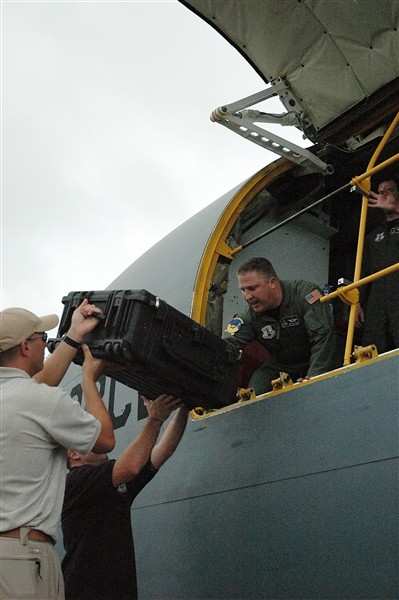KC-135 Crew Recovers Remains From Republic Of Palau
A drama unfolded in the skies above the western Pacific island
nation of Palau on September 1, 1944, as intense fighting between
American and Japanese forces was getting under way. During a raid,
comrades of the US Army Air Forces looked on helplessly as the crew
of a B-24 Liberator bomber, the "Babes in Arms," was brought down
by anti-aircraft fire. Three of the crew reportedly bailed out, one
without a parachute, before the bomber dove headlong into the ocean
never to be found -- or so it was thought back then.

A volunteer Kansas Air National Guard crew in a KC-135
Stratotanker from 190th Air Refueling Wing returned the human
remains recovered from that ill-fated bomber back to this country
in early March.
Thanks to an organization called BentProp, who found the crash
site in 2004, the location is no longer a mystery. BentProp is a
privately funded organization that searches for planes and their
crews who crashed after being shot down by the Japanese in 1944-45.
They reported it to the Joint POW-MIA Accounting Command, who for
the last three years investigated and recovered the remains from
the site. The Kansas Coyotes had the honor of transporting the
fallen back to US soil -- to Hawaii for identification.
"That seemed like a pretty good thing to do to give some closure
to some families back home in the states," Air Force Master Sgt.
Mark Mertel said, adding that it was an honorable thing to do and
"a fine way to end my career with the Kansas Air Guard. I jumped on
it. It's a great opportunity."

The Kansas crew flew from its home at Forbes Field, just outside
Topeka, to Hawaii then Guam and, from Guam, another hour and a half
to the Republic of Palau.
"It was really moving to see that island and kind of imagine
what might have happened that day," Maj. Jeff Warrender said from
the pilot's seat. "It really made me think about how brave those
guys must have been and what they might've gone through before they
died. To see how beautiful the island was, it was just kind of
eerie."
Warrender first did a flyover inspection of the destination, a
short airstrip with no tower that is usually used by smaller
aircraft, in order for the crew to ensure conditions on the runway
would permit a safe landing. Standing water, among other
conditions, might keep the lumbering tanker from landing.
Satisfied, Warrender circled back around, smoothly touched down,
and brought the big plane to a quick halt on the island nation.
Local officials, without whom any of the Palau recovery efforts
would have been possible, met the KC-135 crew on the runway.
Jennifer Anson, executive assistant to the vice president of Palau,
said the event was emotional for her. "A lot of my relatives were
here during the war, and a lot of them went missing and we never
found them," she said.
"I'm happy for whoever's family has that peace of mind now,
knowing that their family members are being returned back home,"
Anson added.

US Navy divers sat in the back of a large truck with their
cargo: two sealed black cases containing the remains of the B-24's
lost crew. These divers, dispatched by Joint POW-MIA Accounting
Command to this site, spent a month and a half under 70 feet of
water meticulously recovering the remains and, in some cases,
personal effects of the bomber's crew.
When BentProp personnel find a site, they tell JPAC, and an
investigation is begun involving archaeologists, doctors, forensic
scientists, divers, and whoever else is required to recover and
identify a servicemember so that a family might be notified and the
remains appropriately honored.
At the tanker, Air Force Capt. Jarrod Ramsey, a pilot, and
Master Sgt. Matt Miltz, a refueling boom operator, carefully helped
the divers, who handed the cases up from the truck into the side
cargo door of the KC-135. Other members of the crew got the
aircraft ready to fly again, checking and rechecking its structure
and systems.
At the end of the runway, the engines whined louder and louder
about not going anywhere as the pilot let their power build.
Finally, the pilot released the brakes, and the tanker rocketed
down a rapidly shortening runway and into the Pacific sky with the
remaining crew of the Babes in Arms finally on their way to
completing a trip that took much longer than anyone would have
imagined.

After a quick stop back in Guam, the KC-135 flew east to Hawaii,
where the remains of the B-24 crew would be examined forensically
by JPAC experts to verify their identities. Once identified, the
servicemembers will be flown the rest of the way home to their
families, but that honor will be for another aircrew. The Kansas
Coyotes had accomplished their mission.
"We've had some fairly long days, and not a lot of ground time,"
Miltz explained. "But it's all been worth it, helping to bring
these people back."
(Aero-News salutes Staff Sgt. W. Michael Houk, National
Guard Bureau)
 ANN's Daily Aero-Term (04.26.24): DETRESFA (Distress Phrase)
ANN's Daily Aero-Term (04.26.24): DETRESFA (Distress Phrase) Aero-News: Quote of the Day (04.26.24)
Aero-News: Quote of the Day (04.26.24) ANN's Daily Aero-Term (04.27.24): Direct
ANN's Daily Aero-Term (04.27.24): Direct ANN's Daily Aero-Linx (04.27.24)
ANN's Daily Aero-Linx (04.27.24) Aero-News: Quote of the Day (04.27.24)
Aero-News: Quote of the Day (04.27.24)






